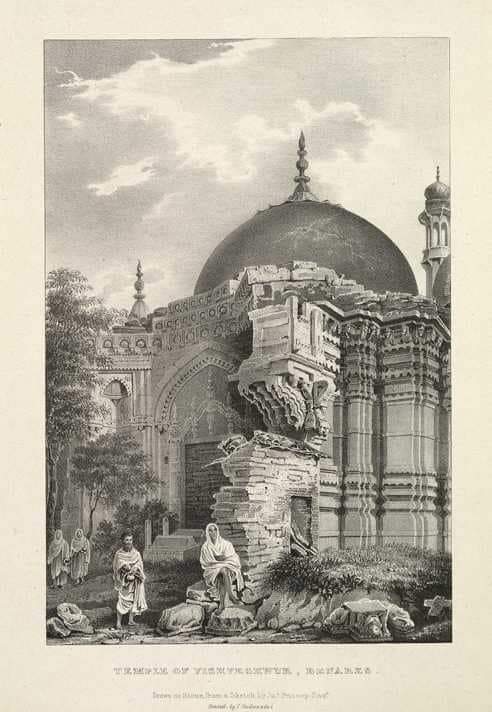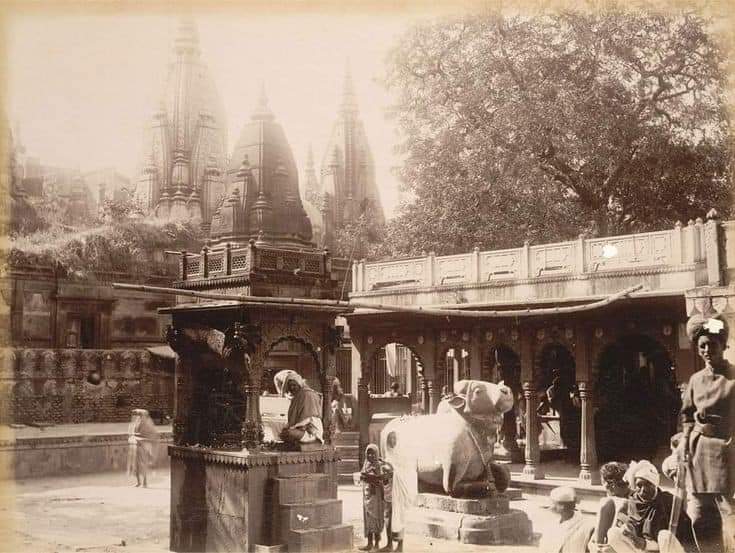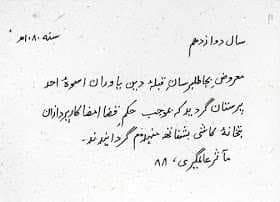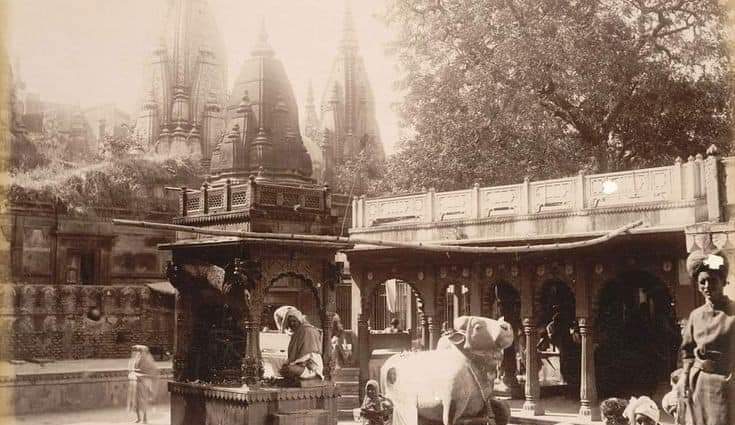Destruction of Kashi Vishwanath Temple and dispute of Gyanvapi mosque
ভারতের সুপ্রাচীন জ্যোতির্লিঙ্গ কাশী বিশ্বনাথ মন্দিরের রক্তাক্ত ধ্বংসের ইতিহাস।
______( for english and more details see full post)
গঙ্গা যেখানে উত্তরবাহিণী, সেই বারাণসীর পশ্চিম কূলে কাশী বিশ্বনাথ বিরাজমান। বিশ্বনাথের মন্দিরে অবস্থিত পবিত্রতম জ্যোতিরলিঙ্গ কাশী বিশ্বনাথের। অনেক পুরাণেই এর উল্লেখ আছে, স্কন্দ পুরাণের কাশী খন্ড সমেত।
বিশ্বনাথের আদি মন্দির কতবার সংস্কৃত হয়েছে, কবে প্রথম তৈরি, তা এখনো খুব পরিস্কার নয়। এইটুকু বলা যায়, পৃথিবীর প্রাচীণতম শহরের নাম কাশী/ বারাণসী, যেখানে বরুণা আর অসি নদী গঙ্গায় এসে মিলেছে। বিশ্বনাথ এখানে বিরাজমান অন্নপূর্ণার সঙ্গে। ১১৯৪ সালে মহ্ম্মদ ঘোরী প্রথম এই মন্দির ধ্বংস করে। দিল্লীর সুলতান ইলতুতমিসের (১২১১-৬৬) সময়ে এক গুজরাতি ব্যবসায়ী বিশ্বনাথের মন্দির পুনরায় নির্মাণ করেন। এই মন্দির আবার ধ্বংস করে হুসেন শাহ শিক্রি (১৪৪৭-৫৮) অথবা সিকান্দার লোদী (১৪৮৯-১৫১৭)। রাজা মানসিংহ এই মন্দির আবার তৈরি করেন ১৬৬৯ সালে। আওরাংজেব এই মন্দির আবারও ধ্বংস করে এবং সেই মন্দিরের ুপরে তৈরি করে জ্ঞানব্যাপী মসজিদ ১৬৬৯ সালে।

এখনো জ্ঞানব্যাপী মসজিদের দেওয়াল দেখলে যে কেউ দেখতে পাবেন কিভাবে মন্দিরের ভগ্নাশ ব্যবহার করে এই মসজিদ তৈরি হয়েছে। ১৮২৪ সালে এক ব্রিটিশ পর্যটক রেজিন্যাল্ড হেবার লিখেছিলেন, আলমগীর এক হিন্দু মন্দিরকে ধ্বংস করে মসজিদ বানিয়েছিলেন, যে মন্দির হিন্দুদের কাছে অতি পবিত্র বলে মান্য। এখন যে মন্দির, তা ইন্দোরের রাণী অহল্যাবাই নির্মাণ করিয়েছিলেন ১৭৮০ সালে। (প্রসঙ্গত অহল্যাবাই সোমনাথ এবং আরো কিছু মন্দির পুনর্নির্মাণ করান, যেখানে জ্যোতিরলিঙ্গ বর্তমান।) হেবারের কথা অনুযায়ি, এই জায়গা ছিল যেন মন্দিরের সভাগৃহ, যেখানে ভক্তরা রাম নামগান করত, পোষা ষাঁড়েদের অনায়াস বিচরণ ছিল যেখানে, যার চিহ্ন এখনো দেখা যাবে মসজিদের পিছন দিকের দেওয়ালে, যা এক সময় ছিল কাশী বিশ্বনাথ মন্দির। ১৮২২ সালে জেমস প্রিন্সেপ তাঁর আঁকা এক ছবিতে এই মসজিদের পিছন দিকের দেওয়ালকে ‘বিশ্বেশ্বরের মন্দির’ বলে উল্লেখ করে গেছেন। এখনো হিন্দুরা এই মসজিদের ভিত্তিভূমিকে কাশী বিশ্বনাথের মন্দির বলে পুজো দেন। ১৮৬৮ সালে এম এ শেরিং লেখেন, আওরাংজেবের ধ্বংস করা মন্দিরের দর্শনীয় অবশেষ এখনো রয়ে গেছে মসজিদের পশ্চিম দিকের দেওয়ালে। ১৮০৯ সালে হিন্দু-মুসলিম দাঙ্গার সময়ে মুসলিমরা হিন্দুদের কাছে পবিত্রতার প্রতীক গরু কেটে ফেলে এখানে এবং সেই রক্ত পবিত্র জ্ঞানব্যাপী কুয়োতে ঢেলে দেয়। প্রতিশোধ নিতে হিন্দু জনতা মুস্লিমদের কাছে অপবিত্র শুয়োর কেটে অনেক মসজিদের ভিতরে ফেলে আসে। এই দাঙ্গায় দু’ পক্ষের অনেকেই নিহত হয়।

বর্তমানে কাশী বিশ্বনাথ ধাম পথ নির্মাণের সময়ে এখন পর্যন্ত চল্লিশটি পাচীণ মন্দিরের অবশেষ পাওয়া গেছে। কাশী, বারাণসী, বেনারস, যে তিন নামে এই জায়গা পরিচিত, তা ইতিহাসের নানা পর্বে চিহ্নিত হয়েছে। কাশি সব সময়েই মহান শিক্ষা, জ্ঞানী, তপস্বী আর সাধুদের ক্ষেত্র। রামচরিতমানস রচয়িতা গোস্বামী তুলসীদাস এখানেই জীবন কাটিয়েছেন। এখানেই আদি শংকরাচার্য রচনা করেছিলেন মণীষা পঞ্চকম। এখানেই চার জন জৈন তীর্থঙ্কর – সুপরশ্বনাথ (সপ্তম), চন্দ্রপ্রভু (অষ্টম), শ্রেয়াংস্নাথ ((একাদশ), পার্শ্বনাথ (তেইশ) জন্মেছেন। এখানেই শিখ গুরু গোবিন্দ সিং তাঁর পাঁচ শিষ্যকে পাঠিয়েছিলেন সংস্কৃত শিক্ষার জন্য, যাদের দ্বারা পরে নির্মল শিখ শাখার সৃষ্টি।
পুরাতাত্ত্বিক অনুসন্ধানে জানা যাচ্ছে, এই নগরী অন্তত আট হাজার বছরের পুরোণো জনপদ, যেখানে সাড়ে তিন হাজার বছরের উন্নত ইতিহাস প্রতিষ্ঠিত। প্রাচীণকালে কাশীকে মৃত্যু এবং ধ্বংসের সঙ্গে যুক্ত করা হয়েছিল। এই প্রাচীণ শহরের একটি পবিত্র কুয়ো জ্ঞান বাপী নামে পরিচিত (যে কুয়ো প্রজ্ঞার প্রতীক)। কথিত আছে, বিধর্মী আক্রমণের সময় জ্যোতিরলিঙ্গ নিয়ে প্রধান পুরোহিত এই কুয়োয় ঝাঁপ দিয়েছিলেন, বিধর্মীর স্পর্শ যাতে না লাগে।
কাশী বিশ্বনাথ মন্দির বারে বারে বিধর্মীদের হাতে ধ্বংস হয়েছে, আবার গড়ে উঠেছে ১৬৩২ সালে শাহজাহান এই মন্দির ধ্বংসের চেষ্টা করে বিফল হয় হিন্দুদের প্রবল প্রতিরোধে, কিন্তু কাশীর ৬৩টি টি অন্য মন্দির ধ্বংস হয়ে যায়।
আইনি যুদ্ধের কাহিনিঃ
বারাণসীর ফার্স্ট ট্র্যাক কোর্টে প্রথম মামলা ওঠে স্বয়ম্ভু ভগবান বিশ্বনাথ এবং উত্তরপ্রদেশ সুন্নি ওয়াকফ বোরডের মধ্যে। ওয়াকফ বোরডের সঙ্গে যুক্ত হয় অঞ্জুমান ইন্তেজমিয়া বানারস। ওয়াকফ বোর্ড ভারতীয় পুরাতত্ত্ব সরবেক্ষণের অনুসন্ধানের উপর স্থগিতাদেশ চাইলে তা প্রত্যাখ্যাত হয়। পরার শুনানীর তারিখ সতেরো ফেব্রুয়ারী, ২০২১। কাশী বিশ্বনাথ এবং জ্ঞানব্যাপী মসজিদের আইনি লড়াই একই সঙ্গে সেসন্স কোর্ট এবং হাইকোর্টে চলছে। ইতিমধ্যে ASI মসজিদ এলাকা পর্যবেক্ষণের আবেদন করেছে এবং যথারীতি মুস্লিম পক্ষ তাতে আপত্তি জানিয়েছে। এলাহাবাদ হাইকোর্ট নিম্ন আদালতের রায় বহাল রেখেছে।
ইতিমধ্যে চল্লিশটি মন্দির পুনরাবিস্কৃত হয়েছে। কোনো সভ্যতার সাংস্কৃতিক ঐতিহ্য ধ্বংস করতে চাইলে তার ইতিহাসকে ধ্বংস করতে হয়। সেইভাবেই বিজাতীয় আক্রমণকারীরা সব সময়ে চেষ্টা করেছে এই দেশের ইতিহাস, শিল্প, স্থাপত্য, সাহিত্য, জ্ঞান –বিজ্ঞান ধ্বংস করতে। ইতিহাস থেকে কেউ যদি শিক্ষা না নেয়, তাহলে অপমানের ইতিহাসের পুনরাবৃত্তি হয়।

🏹 Kashi Vishwanath Temple stands on the western bank of the holy river Ganga, and is one of the twelve Jyotirlingas, the holiest of Shiva Temples. The main deity is known by the name Vishwanath.
🏹 The temple is mentioned in the Puranas including the Kashi Khanda of Skanda Purana. The original Vishwanath temple was destroyed by army of Mohammad ghori in 1194 CE, The temple was rebuilt by a Gujarati merchant during the reign of Delhi’s Sultan Iltutmish (1211–1266 CE). It was demolished again during the rule of either Hussain Shah Sharqi (1447–1458) or Sikandar Lodhi (1489–1517). Raja Man Singh built the temple .
In 1669 CE,again
🏹 Aurangzeb destroyed the temple and built the Gyanvapi Mosque in its place.
The Gyanvapi mosque was built by the Mughal emperor Aurangzeb in 1669 CE, after destroying a Hindu temple.The remnants of the Hindu temple can be seen on the walls of the Gyanvapi mosque.The demolished temple is believed by Hindus to be an earlier restoration of the original Kashi Vishwanath temple. The original temple had been destroyed and rebuilt a number of times. The temple structure that existed prior to the construction of the mosque was most probably built by Raja Man Singh during Akbar’s reign.
🏹 Hindu worship in the Gyanvapi precinct
Describing the site in 1824, British traveler Reginald Heber wrote that “Aulam Gheer” (Alamgir I i.e. Aurangzeb) had defiled a sacred Hindu spot and built a mosque on it. He stated that Hindus considered this spot more sacred than the adjoining new Kashi Vishwanath temple (which had been rebuilt by Ahilyabai Holkar in 1780). He described the site as a “temple court”, which was crowded with tame bulls and naked devotees chanting the name of Rama.
🏹 A temple structure can be seen at the mosque’s rear wall, long believed to be a remnant of the original Kashi Vishwanath temple. In 1822, James Prinsep captioned an illustration of the rear wall as “temple of Vishveshvur” in his Benares Illustrated. The Hindus worshiped the plinth of the mosque as the plinth of the old Kashi Vishwanath temple.M. A. Sherring (1868) wrote that the “extensive remains” of the temple destroyed by Aurangzeb were still visible, forming “a large portion of the western wall” of the mosque. He mentioned that the remnant structure also had hindu temple elements .
🏹 During the Hindu-Muslim riot of 1809, a Muslim mob killed a cow (sacred to Hindus) on the spot, and spread its blood into the sacred water of the well. In retaliation, the Hindus threw rashers of bacon (haram to Muslims) into windows of several mosques. Subsequently, both the parties took to arms, resulting in several deaths, before the British administration quelled the riot.
🏹 During clearing process of “Kashi Vishwanath Dham Corridor”, over 40 ancient temples were discovered in Kashi. The temples are said to have historic and religious significance as per ‘Kashi Khand of Skand Puran’. The temples which were found hidden behind the wall of buildings of Kashi strike questions over the brutalised history of Kashi.
Kashi, Varanasi, Benares, are the three different names of the same city, denoting different era’s of history of Kashi. Kashi consisted of great scholars, sages, saints, philosophers, etc. Kashi is the land where Goswami Tulsidas spent most of his life and wrote Ramcharitamanas while travelling to Ayodhya and Kashi frequently, the land where Adi Shankaracharya wrote Manisha Panchakam, where four of Jain Tirthankaras Suparshvanath(7th), Chandraprabhu(8th), Shreyanshnath (11th) and Parshvanath(23th) Tirthankaras were born, where Guru Gobind Singh sent the five Sikhs to study Sanskrit and later their teachings came to be known as the Nirmala Sikhs .
🏹 Archeological excavations of Kashi prove it to be more than 8000 years old whereas the documented golden history of the city is of more than 3500 years. In anciuent times, Kashi was also subjected to subjected to death and destruction.
There is also a small well in the temple known as Gyaan vapi (the wisdom well). It is believed that the main priest of the temple jumped into the well with Jyotirlinga to protect it from invaders.
🏹 The city of Kashi was ravaged countless number of times by foreign invaders while Indians had rebuilt it after its destruction.
Shah Jahan, in 1632, had passed the order to demolish Kashi Vishwanath Temple. However, his armies were not succcessful in destroying Kashi Vishwanath Temple due to strong opposition from the Hindus, but succeeded to demolish 63 other temples in Kashi.
🏹 Legal battle :
The trial on between Swayambhu Bhagwan Vishwanath and UP Sunni Waqf Board in the fast track court of Varanasi. Anjuman Intejamia Banaras is also with the Waqf Board in this matter. The Muslim side demanded that the stay on the ASI survey of Kashi Vishwanath in the case be maintained, but the court has rejected their demand. Now the next hearing on the demand of the plaintiff side of the Archaeological Survey of Gyanvapi Masjid will be on 17 February.
The case of Kashi Vishwanath and Gyanvapi Mosque was going on in both the High Court and the Sessions Court. Later the High Court said that the trial will run in the same court and will continue in the sessions court. On behalf of the plaintiff side, an application was made by ASI to conduct a physical survey of the entire Gyanvapi campus, to which the Muslim side objected.
Allahabad HC Stays Varanasi Court’s Order To Commence Hearing On Kashi Vishwanath Temple-Gyanvapi Mosque Land Title Dispute.
🏹 Fortunately, over 40 temples with architectural marvels have been recovered intact from Kashi.
🏹 Demolition of heritage is an easy way to destroy the civilizations of nation. This is how foreign invaders tried to demolish our civilisation. History is a great teacher. Those who do not learn from history, those who do not remember their past are condemned, are destined to repeat the same mistakes. Discovery of more than 40 ancient temples are concrete proof of our history which is described and dismissed as mythology. It is high time to connect people of India with their glorious past as these concrete proofs are screaming out to be our glorious history
(Thank you : Ajoy Konar
Opindia
Manisha Inamdar
Kashi Vishwanath corridor project
Museum archive of Bikaner Rajasthan
Banaras museum)
সমতা

